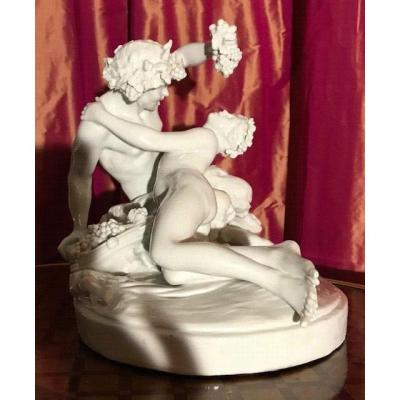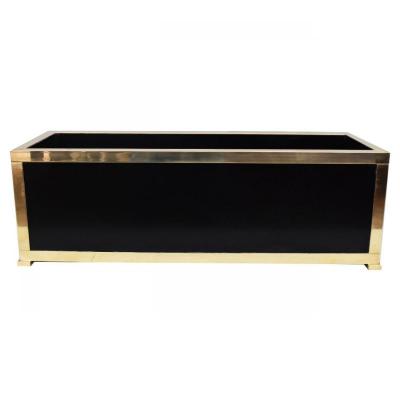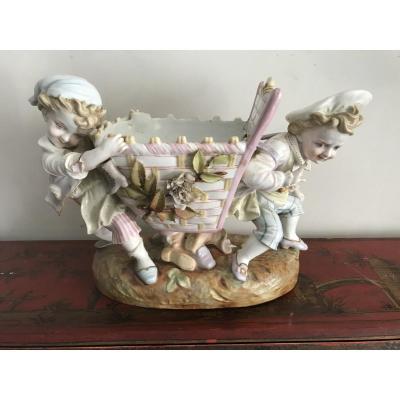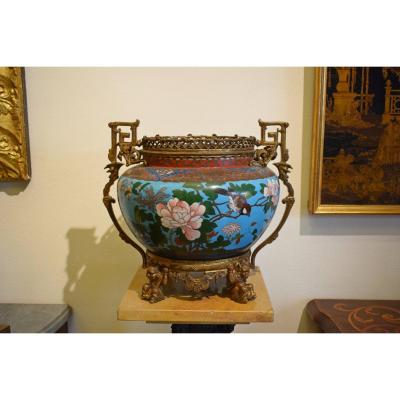In harmony with the purpose of this refined furniture object, a richly crafted gilded bronze set of Louis illuminate its curved profiles (ribboned falls of fruit and flowers, foliage garland of flowers in applique) and punctuate its side walls (fixed handles with voluble decoration of shell-palmettes, wavy half-shells, leafy scrolls of acanthus and flowers).
Scalloped with an openwork gallery with motifs of palmettes, florets and stylized scrolls, the planter rests on four feet with foliage scrolls topped with a pierced rocaille cartouche.
It is also equipped with its original zinc lining equipped with movable grip rings.
Our Living Room Planter is by its quality - use of Rosewood, a precious species favored during the 1850s by luxury cabinetmaking; decorative richness of gilded bronzes associated with the delicacy of polychrome porcelain with naturally painted floral decoration in the spirit of the productions of the Sèvres Manufacture of the 17th century - to be compared to the tasteful and fancy cabinetmaking creations offered in the second half of the 19th century by distinguished Parisian houses highly sought after by the elite and upper bourgeoisie of the Second Empire for "their cabinetmaking works, charming and very remarkable, some for their elegance and good taste, others for the novelty of their models, all by the perfection of their work". Although not stamped, it could bear the signature of Georges Alix, Alphonse Giroux, Lemarchand, Alexandre Tahan and, more likely, Maison Vervelle- Audot, of which she presents elements noted on her signed pieces.
La Jardinière: A sumptuary “artistic fantasy” from the Second Empire:
During the 1860s, there was no antechamber, living room or even boudoir without a planter. Garnishing the mantle of a fireplace, adorning a pedestal table, serving as a centerpiece or placed in front of a window, this one, whatever its shape - mounted porcelain bowl, small "handstand" or on inlaid wooden legs garnished with bronzes - is an integral part of the opulent interiors of Hausmannian Paris. Considered "one of the prettiest pieces of furniture that can decorate an apartment", the Jardinière is intended, "depending on the degree of elegance or simplicity of the furnishing with which it must be in harmony", "more or less rich, more or less decorated. this note of enchanting delight so ardently sought by the society of the time.
Nowadays, flower bouquets, leafy plants or fragile orchids will revive the charms and fragrances within the proposed Jardiniere.
*Elegance of the home: apartment planter, apartment greenhouse, portable greenhouse", in: La Semaine desfamilies: weekly universal review, 1859
-----------------------
Dimensions: H.: 27cm;-L.: 44 cm;-Dr.: 27 cm.
Materials: rosewood veneer; bronze and zinc; polychrome porcelain and gold painted highlights.
Parisian tablet work of good quality in Louis XV style from the second half of the 19th century. Napoleon III period. Circa 1850-1860. Attributable to Maison Vervelle-Audot.
In perfect condition.

























 Le Magazine de PROANTIC
Le Magazine de PROANTIC TRÉSORS Magazine
TRÉSORS Magazine Rivista Artiquariato
Rivista Artiquariato
